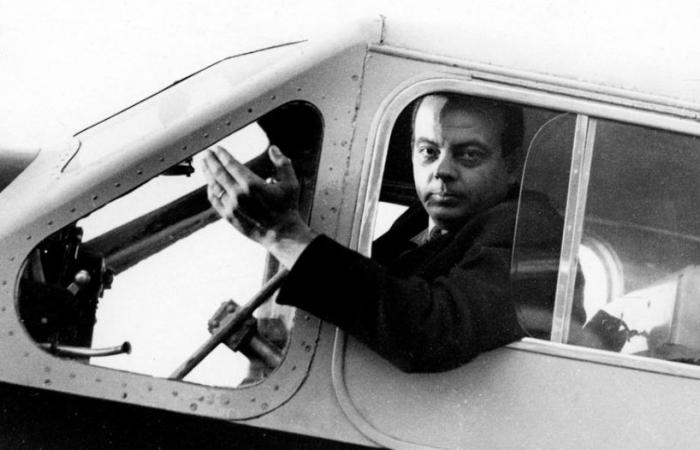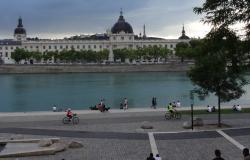“Rest, I will find it either in your arms and under our trees and in the peace of your poetry, when I return from eleven thousand meters, or in a definitive sleep but completely washed of the dirt of their insults” This is what Antoine de Saint-Exupéry wrote at the end of June 1944 from Sardinia to his great love, Consuelo Suncin, who remained in the United States. A month later, more precisely on July 31, it was unfortunately the second outcome that had to be imposed for the war pilot, who went missing that day during a reconnaissance mission.
A poster of the legendary Aéropostale.
The Air and Space Museum looks back at the colourful and tragic destiny of Antoine de Saint-Exupéry through an exhibition presenting some of his personal objects – logbooks, aviator’s clothing and manuscripts – as well as some of the debris from the fuselage of his Lightning P38.
Before reaching this climax, however, we witness Antoine de Saint-Exupéry’s debut as a pilot.
The author of “Courrier Sud” or “Vol de Nuit” trained as a pilot in 1921 during his military service in Neuhof, in the suburbs of Strasbourg. Still undecided about what he wanted to do with his life, he ultimately found his calling in both aviation and writing.
The year 1926 marked the realization of a childhood dream for him: he joined Aéropostale, formerly Latécoère, the airmail service whose pilots were both great travelers and notorious daredevils.
Leaving Le Bourget in 1935, it crashed in the desert
Antoine de Saint-Exupéry flew a Caudron Simoun, as shown here in one of the rooms of the Air and Space Museum.
The proof in 1935: an adventurer with a taste for records like Mermoz or Nungesser, Saint-Exupéry also wanted his feat of arms. With André Prévot, his mechanic, they embarked north of a Caudron-Simoun on a Paris-Saigon to be completed in less than 4 days. But the mission, which actually departed from Le Bourget, was cut short: the two men crashed in the middle of the Libyan desert and owed their lives to Bedouins, who saved them from dying of thirst. According to legend, the hallucinations that Saint-Exupéry then experienced were the raw material for The Little Prince, which was born under his pen in 1943.
The interwar period was also for this humanist the time of creation, literary, then cinematographic: some beautiful posters of “Vol de Nuit”, adapted for the cinema by the Americans in 1933, then “Anne-Marie” are also exposed.
A model of a P-38 Lightning like the one Saint-Exupéry was flying when he disappeared at sea on July 31, 1944.
Then comes the time of war: despite his 43 years, the pilot, exiled in the United States, manages to enlist as a reconnaissance pilot. His missions: to take aerial photos that indicate enemy positions and the forces present. This is also the goal of his mission of July 31, 1944. Leaving Bastia-Borgo aboard a Lightning P-38, an American-made plane, recognizable among thousands by its double tail, the pilot of squadron II/33 must take photos to prepare for the Allied landing in Provence (which will indeed take place on August 15).
But while his return is expected at 12:15 p.m., he will never return. In the newspapers of the time, there was consternation. For years, there was an almost total mystery surrounding his disappearance. But in 2003, an exploration of the seabed off the coast of Marseille took place after a bracelet bearing the poet’s name had already been found in front of Ile Riou. Banco: divers fall 80m deep on remains of Saint-Exupéry’s plane. One of the landing legs and a turbocharger can therefore be seen at the Air Museum. In a very detailed film, the Museum team explains how it worked in partnership with the University of Lorraine to restore these pieces, which were quite corroded after 60 years spent in the salt waters of the Mediterranean.
The man who spoke to the heavens himself says goodbye to us, reading the beginning of his beautiful story “Land of Men”: “The earth teaches us more about ourselves than all the books. Because it resists us. Man discovers himself when he measures himself against the obstacle. But, to reach it, he needs a tool. (…) The peasant, in his plowing, gradually tears away some secrets from nature, and the truth that he releases is universal. In the same way the airplane, the tool of the airlines, mixes man with all the old problems.”
Christophe Lehousse
– Antoine de Saint-Exupéry, Fragments of History. Until September 29. 17 euros entry for the entire museum, 14 euros reduced rate, 6 euros from 4 to 18 years old, free every 1st Sunday of the month
Closed on Mondays.






